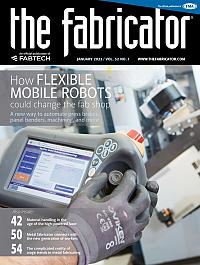Senior Editor
- FMA
- The Fabricator
- FABTECH
- Canadian Metalworking
Categories
- Additive Manufacturing
- Aluminum Welding
- Arc Welding
- Assembly and Joining
- Automation and Robotics
- Bending and Forming
- Consumables
- Cutting and Weld Prep
- Electric Vehicles
- En Español
- Finishing
- Hydroforming
- Laser Cutting
- Laser Welding
- Machining
- Manufacturing Software
- Materials Handling
- Metals/Materials
- Oxyfuel Cutting
- Plasma Cutting
- Power Tools
- Punching and Other Holemaking
- Roll Forming
- Safety
- Sawing
- Shearing
- Shop Management
- Testing and Measuring
- Tube and Pipe Fabrication
- Tube and Pipe Production
- Waterjet Cutting
Industry Directory
Webcasts
Podcasts
FAB 40
Advertise
Subscribe
Account Login
Search
Wage trends and the future of metal fabrication
Metal fabricators need to become employers of choice, and competitive salaries can only help
- By Tim Heston
- January 13, 2022
- Article
- Shop Management

Data within a 2021 wage survey reveal complex realities of the metal fabrication labor market—realities that will define the business for years to come. metamorworks/iStock/Getty Images Plus
Nothing gets people talking in this industry like the lack of skilled labor—or, at present, the lack of labor period. No fabricator really can automate all its labor problems away, though automation has become an increasingly important part of the puzzle.
Of course, some fabricators can automate more. Indeed, a large portion of respondents to the “2022 Capital Equipment Forecast,” to be released soon by the Fabricators & Manufacturers Association Intl. (FMA), said the lack of labor would be a big driver behind their capex strategy moving forward.
Still, even the best automation wouldn’t be very effective without good people, and good people require a competitive salary. Trends revealed in the 2021 “Salary/Wage & Benefit Survey,” published by FMA, give some insight into what a competitive wage really is.
Stability Before Chaos
In the survey’s introduction, Steve Zerio, member of FMA’s Management Advisory Council and president of Triumph Partners, a Michigan-based consultancy, wrote, “About 69% of participants estimate 2022 pay raises of 2% or more, compared to only 47% a year ago. Hearing how busy many FMA members are currently, this shows the intention to fully address compensation. … The survey shows relative stability in a time of personnel chaos, though some chaos may not be seen until the 2022 survey.”
Wage increases in metal fabrication were most profound on the shop floor. While executives saw average annual increases of just 1.6% and those in the office 2.3%, shop floor workers saw pay rise 3.1%. This trend is likely to continue. Of course, giving wage increases that significantly outpace productivity gains puts a fabricator in a tough spot. But when a shop has the right technology and can get more out of every payroll dollar, it’s headed in the right direction.
In this respect, fabricators have been headed in the right direction. The custom metal fabrication participants of FMA’s 2021 “Financial Ratios & Operational Benchmarking Survey” (covering the 2020 fiscal year) reported an average sales-per-employee metric of more than $208,000, down slightly from $214,000 reported the prior year, but up significantly from the $170,000 reported three years ago.
Market Forces Affecting Wages
Several labor market forces could be affecting wage growth in metal fabrication. For jobs less affected by automation, the tight labor market is driving wages skyward, especially for those with broadly applicable skills—such as those who can drive a fork truck. Since 2018 fork truck drivers’ wages have risen just as much or often more than skilled machine operator positions, at least when measured by the wage median.
According to the 2021 survey, most forklift drivers (those between the 25th and 75th percentile) made between $32,240 and $41,600, with a median of $39,520. The average was nearly identical, at $39,810. Positions with higher averages than medians tend to have more salaries grouped at the top of the spectrum. Those top salaries pull the average wage higher. For fork truck drivers, this isn’t happening.
Wages for more specialized and skilled positions are trending differently. Starting wages remain low at some companies, but the mean salaries are higher than the median. Translation: More are reporting salaries at the upper end of the income range. Prime examples include both experienced press brake and laser cutting machine operators. Their mean salaries are higher than the median, sometimes by thousands of dollars. Both have a few at the extremes who make very low and very high salaries. But again, a greater number of higher salaries are pulling the average salary higher.
This might reflect what remains a complicated reality. Automation allows less-skilled people to become more productive. Their pay might be average or even on the low end, though, because it doesn’t take years of training to get someone up to speed—at least for some of the shop’s simpler work, particularly if someone else programs and sets up a machine. They’re probably required to measure parts, fill out inspection paperwork, and report problems. But to fix major problems, they call the department lead for help.
What’s the career path for such operators? Some might be happy clocking in, experiencing a predictable workday, and going home. Others might climb the ladder by becoming floaters, cross-training on multiple machines. According to the FMA survey, wages for operators of multiple machines show the same trend as brake and laser operators: A greater number of higher salaries push the mean higher than the median. Some might choose to specialize on one machine, one day becoming the department lead or technical guru—again, one among the many higher-wage individuals that push the job’s average wage higher.

During a webinar about FMA’s 2021 wage and benefit survey, Steve Zerio, president of Michigan-based Triumph Partners, illustrated four interlapping factors behind employee satisfaction: compensation, engagement, development, and resources.
Or they could move on to supervision or management. Of course, this business is dominated by small shops where there can be only so many chiefs. So a few might move on to other areas, like programming or estimation.
Jobs like programming and estimating exemplify the profound impacts of technological change, including the benefits and challenges it presents for employers trying to attract people to the industry. Some shops might manually nest a repeat order and use Excel sheets to put together an estimate for the sales team—but a few operations have nearly or completely automated both processes.
Sure, such software automation doesn’t apply to every fabricator’s business model. But the mere fact that these job duties can in some cases be completely automated, with 1s and 0s doing all the work teams of humans used to do, will likely affect careers involving these skill sets. According to the FMA salary survey, most estimators make between $52,000 and $70,000 a year. In the coming years, however, as the process becomes driven more by software and perhaps even artificial intelligence and machine learning, careers in estimating might change.
This doesn’t mean current estimators will lose their jobs. Fabricators these days wouldn’t dare let such experience walk out the door. But in the future, those who once specialized in estimating might wear multiple hats.
Exciting Time for Metal Fabrication
As part of his FMA webinar, Zerio showed a slide with four intersecting components that make up employee satisfaction: compensation, engagement, development, and resources. Compensation is at the top, for obvious reasons, but it doesn’t stand alone. Engagement plays a role, including the use of in-company surveys, town-hall meetings, company picnics, employee recognition programs, even company swag. Still, Zerio added that all these elements won’t help employee engagement without honest communication about the health of the business and its future. “Consistent, open, honest communication is the real source of employee engagement,” he said.
Next comes employee development. Employees need career plans, and this might include additional internal and external training. When learning never stops, going to work becomes more interesting.
Finally, employees need the resources to do their job. This includes tools and machinery, but it also includes a business structure that makes their work life easier. A business full of functional silos (both real and perceived)—with everyone working to maximize their own metrics with little regard to what’s “over the wall” in another department—creates a breeding ground for employee frustration.
Get Ready for Quite a Ride
Improving employee retention is a complicated puzzle. But if all these pieces of the puzzle are in place, then a metal fabrication operation can offer quite a career—one anchored by decades of technical expertise, but also on the cusp of significant change. New technologies like AI and machine learning are not only pushing shops to run their operations in new ways.
Someone starting in a fab shop today will likely witness dramatic changes driven by technology and changing shop floor demographics. A fabricator’s youngest employees today can’t remember a time before smartphones. They also see automaton as a natural part of the manufacturing landscape; its presence might be the very reason they chose to work in the field.
As fabricators head into 2022, with the weakness of global supply chains exposed and the demand for domestic manufacturing on the rise, metal fabrication is on the cusp of big change and unprecedented opportunity. Those who choose to work in the field are in for quite a ride.
About the Author

Tim Heston
2135 Point Blvd
Elgin, IL 60123
815-381-1314
Tim Heston, The Fabricator's senior editor, has covered the metal fabrication industry since 1998, starting his career at the American Welding Society's Welding Journal. Since then he has covered the full range of metal fabrication processes, from stamping, bending, and cutting to grinding and polishing. He joined The Fabricator's staff in October 2007.
subscribe now

The Fabricator is North America's leading magazine for the metal forming and fabricating industry. The magazine delivers the news, technical articles, and case histories that enable fabricators to do their jobs more efficiently. The Fabricator has served the industry since 1970.
start your free subscription- Stay connected from anywhere

Easily access valuable industry resources now with full access to the digital edition of The Fabricator.

Easily access valuable industry resources now with full access to the digital edition of The Welder.

Easily access valuable industry resources now with full access to the digital edition of The Tube and Pipe Journal.
- Podcasting
- Podcast:
- The Fabricator Podcast
- Published:
- 04/16/2024
- Running Time:
- 63:29
In this episode of The Fabricator Podcast, Caleb Chamberlain, co-founder and CEO of OSH Cut, discusses his company’s...
- Trending Articles
Capturing, recording equipment inspection data for FMEA

Tips for creating sheet metal tubes with perforations

Are two heads better than one in fiber laser cutting?

Supporting the metal fabricating industry through FMA

Omco Solar opens second Alabama manufacturing facility

- Industry Events
16th Annual Safety Conference
- April 30 - May 1, 2024
- Elgin,
Pipe and Tube Conference
- May 21 - 22, 2024
- Omaha, NE
World-Class Roll Forming Workshop
- June 5 - 6, 2024
- Louisville, KY
Advanced Laser Application Workshop
- June 25 - 27, 2024
- Novi, MI


























